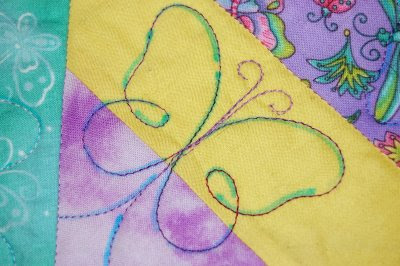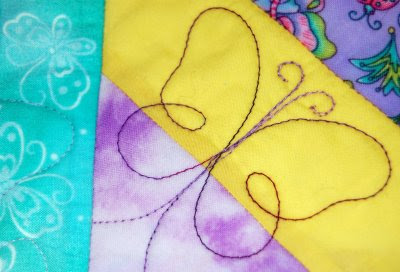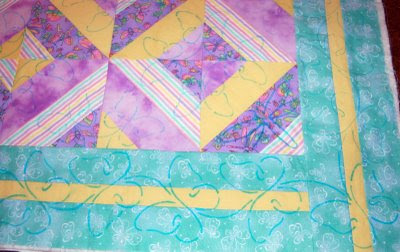Rather than layer a top with batting and backing, the block is quilted directly onto the batting, as a foundation, during construction. I found I needed an acrylic ruler to keep the strips in line while adding them or the squares didn't come out quite right.
Once the blocks are constructed, they are sewn into strips, then sewn to the backing. This is where I ran into some trouble. There was too much slack on the back, so I removed the stitching. Instead I continued to sew fabric and batting together until the top was completed. Then I layered the top/batting to the backing.
For the quilting I stitched-in-the-ditch through all the construction lines and borders. I added quilt lines around the center green block and quilted in a square a couple of seams away from that. Really simple quilting with a walking foot and it turned out well.
Another quilt-as-you-go method involves stitching all three layers together block-by-block, then sewing them together.
I faced a bit of a quandary when binding this quilt. I had to use what fabric was trimmed away from the back. I cut 2" strips from all the remaining fabric and ended up just 3" short of enough. What to do? I decided to sew together two short strips 1-1/8" x 6" to make a 2" wide strip When I pressed them in half, the seam line was on the fold that was handsewn to the back. Easy to disguise and a good solution when you don't have enough fabric in the width you need--piece them!
Copyright ©2008, Sharon Baggs
 Some pens come with a blue water soluble marker at one end and a white eraser pen at the other. This is helpful when you need to remove a marked line in a small area. For larger areas, wet a paper towel with COLD water to lift the markings. You must wait for the fabric to dry before marking again or it will not hold the mark.
Some pens come with a blue water soluble marker at one end and a white eraser pen at the other. This is helpful when you need to remove a marked line in a small area. For larger areas, wet a paper towel with COLD water to lift the markings. You must wait for the fabric to dry before marking again or it will not hold the mark.














 These Olympics, from the precision of the Opening Ceremonies to the architectural design of both the Water Cube and Bird's Nest Olympic Stadium, plus the aesthetically pleasing color scheme and swirly designs on banners everywhere, have been nothing short of awesome. It was my intent to work on UFO's while watching Michael Phelps repeatedly win gold but so far I've just been viewing and not really sewing.
These Olympics, from the precision of the Opening Ceremonies to the architectural design of both the Water Cube and Bird's Nest Olympic Stadium, plus the aesthetically pleasing color scheme and swirly designs on banners everywhere, have been nothing short of awesome. It was my intent to work on UFO's while watching Michael Phelps repeatedly win gold but so far I've just been viewing and not really sewing.



